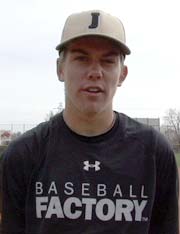From the Desk of Matt Schilling, Director of On-Field Instruction on, “The Most Common Hitting Flaws” Part 1
The Most Common Hitting Flaws
As one of the lead instructors at the Baseball Factory, the nation’s Leader in Player Development and College Placement, and Director of On-Field Instruction, I have the opportunity to work with and train a number of high school baseball players. At the Baseball Factory we see over 3,000 high school hitters every year. Through the years, I have noticed five main mechanical flaws. Please understand that there is much more to hitting than just mechanics, but in order to be a consistent hitter, you must develop sound hitting mechanics as it is critical to your advancement.
Most Common Hitting Flaws – #1
Failure to reach a good launch position – In order to fix this problem, it is essential that everyone understand the concept of a launch position. When a hitter digs in the box and gets ready for the pitch he is in his “stance.” The batter should assume his launch position once the pitcher winds up and is about to release the ball. This position allows the hitter to “launch” his swing.
I like to compare this position to that of a boxer. As a boxer dances around the ring, he maintains his “stance.” When he is ready to throw a punch he will take a step and draw his hand back into position to throw a punch, which is his “launch” position. Could you imagine a boxer trying to knock someone out without loading up to punch? It is essential that hitters establish a launch position that is strong and balanced.
As the pitcher winds up and is about to release the ball the batter should take a short, soft, stride forward with his lead foot. Meanwhile his hands go straight back anywhere from 3-5 inches. He should keep his wait on his back leg. This is the launch position. A good “launch” position should allow a hitter to keep his weight back properly, and to “load” energy that when released during his swing, will increase his ability to drive the ball.
Many high school hitters that I see never reach a good “launch” position and their swing is doomed to fail right from the start. Some of the problems that I see are:
–Weight comes forward too much, hitter dives in.
-Hands don’t load back and the hitter, therefore, cannot generate any power.
-Hands drop instead of going straight back, hitter therefore swings up on everything, has a long looping swing and hits pop ups.
-Hitter takes too long of a stride.
How do you correct this problem?
Mirror Drill– In front of a mirror, repeat the stride and load motions as mentioned above. Perform several repetitions, making sure to stride without your weight coming forward, and with your hands getting back 3-5 inches. Your front foot should land on the inside palm of your foot.
Stride and load soft toss– Soft toss either from the side or the front, but do not allow the feeder to toss the ball until you stride and load. The ball should be fed only after you have demonstrated a successful stride/load and have held the final position for a moment.
Pole Drill – With an old wiffle ball bat get into your “stance” facing a pole. Stride and load into your “launch” position and hold that position for 3 seconds. Check yourself to make sure your weight is back and your hands are loaded into a strong position. Next take your swing and hit the pole. You should hit the pole in a normal contact position as if it was a baseball. You can put tape on the pole at different heights to simulate the height of different pitches. Make sure that in your stance the pole is even with your front foot.
The mirror drill and the pole drill allow you to work on this skill without needing a ball or anyone else to help you.
See photographs below
Note: In picture (A) the hitter has reached his “launch” position with his hands too low and his weight a bit too far forward. Picture (B) demonstrates the result of a bad “launch” position. The hands are much too low, the back shoulder dips, and the weight is already spent going forward. In photo (C) the player is beginning to get into his “launch” position, hands are going back, weight is on his backside. In photo (D) the player has reached a strong “launch” position. His hands have “loaded” a good 4 inches, his weight is still mostly on his back side, and he is taking a soft stride with his lead foot. He is in a great position to “launch” his swing.
This is a very frequent mistake found when working with young players but can be corrected with the right drills and hard work. Next month we will continue our discussion on the most common hitting flaws in young players.








